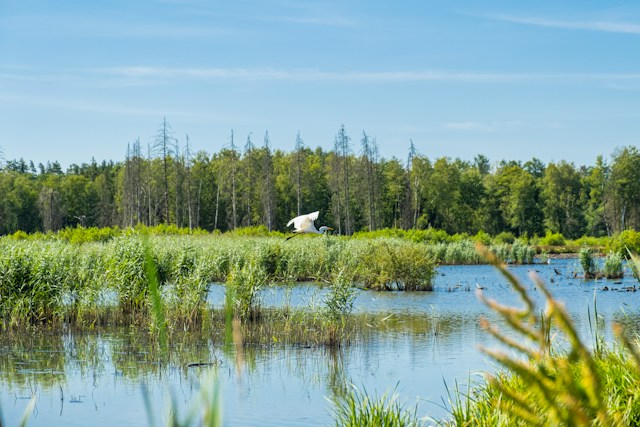Today, urban biodiversity is more than a buzzword. It’s a crucial aspect of modern life that affects everything from climate change to quality of life. And it’s an issue that’s becoming increasingly important for both real estate developers and investors alike. But how exactly can the world of real estate contribute to biodiversity and ecosystem services?
The Intersection of Real Estate and Biodiversity
The real estate sector and biodiversity may seem like two disparate concepts. However, there’s a significant intersection between the two that’s becoming increasingly relevant in today’s sustainability-focused world.
A lire en complément : How can real estate development support the transition to electric public transport?
Biodiversity, or the variety of life in a particular habitat or ecosystem, is a critical component of urban environments. It contributes to ecosystem services – the benefits that people obtain from ecosystems – such as air and water purification, climate regulation, and even recreational benefits. However, urban development often poses significant threats to biodiversity, causing habitat loss, introducing invasive species, and contributing to climate change.
Real estate developers have a crucial role to play in this context. With thoughtful planning and design, they can help mitigate the negative impact of urban development on biodiversity, and even enhance biodiversity in urban areas.
Sujet a lire : What are the best practices for integrating IoT in multi-tenant buildings for energy savings?
Incorporating Biodiversity into Green Infrastructure
Green infrastructure refers to a network of green spaces – and blue if we consider water bodies – that is designed and managed to deliver a range of ecosystem services. It includes elements such as parks, street trees, green roofs and walls, rain gardens, and wetlands.
Green infrastructure is a key tool for real estate developers to enhance biodiversity in urban areas. By integrating green spaces into their projects, developers not only contribute to biodiversity conservation but also create healthier, more attractive environments for people.
For instance, green roofs and walls can provide habitat for a range of species, from birds and bees to various types of plants. These features also provide ecosystem services such as temperature regulation, stormwater management, and air purification, contributing to climate change mitigation and adaptation.
The Role of Sustainable Development
Sustainable development is a type of development that meets the needs of the present without compromising the ability of future generations to meet their own needs. In the context of real estate, it means developing properties in a way that minimizes environmental impact, contributes to the well-being of people, and makes good economic sense.
Sustainable real estate development can significantly contribute to biodiversity. By prioritizing low-impact development, using sustainable materials, and implementing energy-efficient designs, real estate developers can reduce the environmental impact of their projects. Furthermore, by preserving natural areas and incorporating green spaces into their developments, they can enhance biodiversity and provide valuable ecosystem services.
The Business Case for Biodiversity
For real estate investors, biodiversity is not just an environmental issue. It’s also a business issue. Biodiversity loss can pose significant risks to real estate investments, from regulatory risks associated with non-compliance with environmental regulations, to physical risks associated with climate change and natural disasters.
On the other hand, investing in biodiversity can provide substantial business benefits. Properties that incorporate green infrastructure and sustainable designs can command higher rents and property values, attract more tenants and buyers, and enjoy lower operating costs. Furthermore, such properties are better positioned to comply with increasing environmental regulations and to withstand the physical impacts of climate change.
Fostering Biodiversity in Urban Areas
Despite the challenges, real estate developers have a unique opportunity to foster biodiversity in urban areas. With the right strategies and practices, they can turn urban developments into habitats for various species, contributing to biodiversity conservation and providing valuable ecosystem services.
For instance, they can create green corridors – continuous areas of green space that allow species to move around – to link different habitats within and around their developments. They can also use native plants in their landscaping to support local species, and design their projects to minimize light and noise pollution, which can harm wildlife.
Moreover, developers can engage with local communities and stakeholders to promote biodiversity. They can educate residents about the importance of biodiversity, involve them in biodiversity initiatives, and incorporate their input into the planning and design of projects.
In conclusion, real estate development plays a pivotal role in shaping urban biodiversity. With thoughtful planning and design, sustainable practices, and a commitment to community engagement, developers can make a significant contribution to biodiversity and ecosystem services. Not only is this good for the environment, but it’s also good for business.
Shaping Future Cities with Nature-Based Solutions
As urbanisation accelerates worldwide, the need for nature-based solutions to counterbalance its adverse effects on biodiversity becomes more pronounced. Nature-based solutions, or strategies that involve working with nature to achieve certain objectives, are now being integrated into urban planning and real estate development.
Incorporating such solutions into urban development projects can significantly impact biodiversity positively. The use of natural capital or natural resources and ecosystems that yield a flow of benefits to people, is one such approach. For instance, urban wetlands can serve as a natural flood control system, thus avoiding the need for expensive human-made infrastructure. At the same time, these wetlands can also serve as habitats for different species, promoting biodiversity conservation.
Other nature-based solutions include creating green spaces within urban areas or ensuring that existing green spaces are protected during development. These spaces can provide habitats for various species, contributing to biodiversity and providing ecosystem services like air purification and climate regulation.
To be effective, these solutions must be integrated into the broader urban planning process. This means considering biodiversity considerations from the outset when planning new developments or refurbishments. It also involves engaging with local communities, understanding their needs and perceptions, and incorporating their feedback into the planning process.
Addressing Biodiversity Risks in the Built Environment
In the context of urban development, it’s important to address not only the potential contributions to biodiversity but also the potential risks. Real estate development can pose significant risks to biodiversity, including habitat destruction, introduction of invasive species, and increased pollution.
To mitigate these risks, developers can apply a net gain approach. This involves ensuring that the development results in an overall increase in biodiversity, whether by creating new habitats, improving existing ones, or supporting conservation initiatives elsewhere.
One example of this approach is the use of biodiversity offsets, where developers compensate for biodiversity loss caused by their projects by investing in biodiversity conservation elsewhere. This can involve protecting or restoring habitats, supporting species recovery programs, or funding research into biodiversity.
Another strategy is to use sustainable construction practices that minimize the impact on biodiversity. This can involve using materials that have a low environmental impact, minimizing waste, and managing construction activities to limit disturbance to local ecosystems.
In conclusion, the intersection between real estate and biodiversity offers significant opportunities for both conservation and sustainable development. Through thoughtful planning, the use of nature-based solutions, and a commitment to minimizing biodiversity risks, real estate developers can contribute to biodiversity, enhance ecosystem services, and build more sustainable and resilient cities. As urbanisation continues to reshape our world, the need for such nature-positive approaches will only become more critical.











